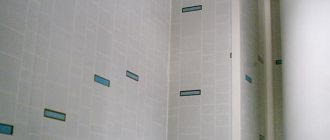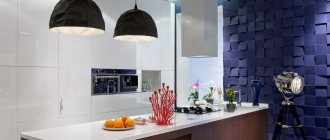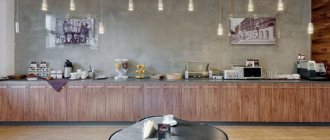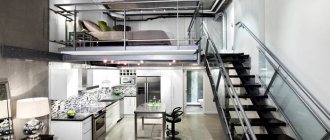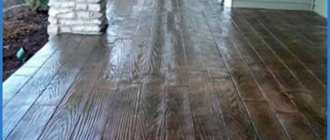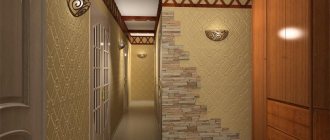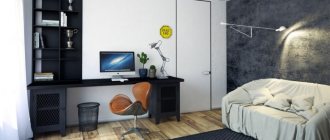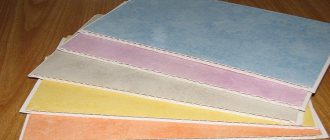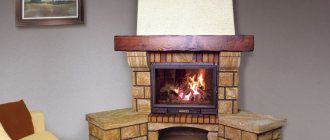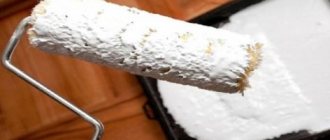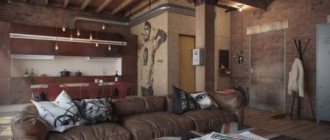Incredibly charming atmosphere of a loft space with concrete-look walls
Among modern finishing materials, it is easy to choose the most unusual solutions for creating an exclusive interior, in particular, concrete-look wallpaper. This type of finish is becoming increasingly popular among fans of the industrial style, but the strict and cold appearance of the concrete surface can fit into a much larger number of design options.
Even if the apartment does not have an open concrete or brick wall, it is quite easy to create an imitation of them by choosing suitable wallpaper. The texture on them looks as realistic as possible, adding a slight negligence to the interior, and the rich palette of gray shades allows you to show your imagination and serves as an excellent backdrop for the future environment.
Among the many colors and textures of concrete on such wallpaper, it is easy to choose the right finish for the living room, dining room, kitchen and even bedroom, without worrying that the room will turn out to be too cold or will look uninhabited.
Despite the fact that concrete coverings have always been associated with the premises of factories and factories, concrete wallpaper can still create a cozy atmosphere in your apartment
Concrete-effect wallpaper perfectly supports a light and bright atmosphere in a spacious bedroom
Textured concrete-like coatings can be diluted with original, unobtrusive abstract prints or designs
Brutal charm
Concrete has migrated from factories and factories to spacious and comfortable lofts, becoming an integral part of them, emphasizing the industrial style of the new generation of homes. Concrete walls, floors or ceilings have become stylish accents, adding their rugged charm to any room. But designers do not limit the use of concrete in finishing only to the loft style; such finishing can take its rightful place in a wide variety of interiors.
Concrete will emphasize the severity of minimalism, add depth to eclecticism, expressiveness to classics or vintage style.
Many people associate bare concrete walls with unfinished construction, constant renovations, and industrial areas. But it’s worth getting rid of this stereotype, because the correct use of concrete in the interior can emphasize the unique design of the room, adding restraint, orderliness, nobility, and delicacy to it.
Given the appropriate surroundings, concrete will look extremely unobtrusive, serving as an ideal backdrop for the decor and an aesthetically attractive stylish accent.
Spacious dining room with walls decorated with concrete-like wallpaper, which does not create unnecessary stress on the interior and gives the room lightness
Advice! A bare concrete wall by itself has no design value, but works only in combination with the right framing and carefully selected elements of the entire setting.
But alas, it is not always possible to use this material in your home; there may simply not be an open concrete wall or it may be in poor condition, and restoration will take a lot of time and effort.
In this case, materials that imitate a concrete surface will help you touch the world of industrial romance. These include decorative plaster, panels and wallpaper. The latter are the simplest option for finishing concrete walls, and in the collections it is easy to choose wallpaper that is ideal in width, pattern, and shade.
Concrete in the interior: how to make fashionable walls in your apartment
Design and Architecture / For Home and Dacha Marina K.
Have you noticed how poetic concrete is? A concrete wall in the interior is very practical, and the complex gray texture can be looked at like a painting for years. Now we’ll try to tell you how to make your dream come true and introduce concrete into your interior.
Noticed: everyone always looks with interest at beautiful photos of interiors with concrete finishes, furniture and even concrete decor. Some are delighted, some are outraged, but no one is indifferent. Concrete is definitely beautiful. True, it is a little difficult to implement, and it is also not appropriate everywhere.
After all, the main problem of using concrete in the interior is that no one knows: a) how to make such repairs: how concrete walls/floors/ceilings are practically made, where to find a skilled craftsman, and what kind of concrete this is;
b) how not to let concrete finishes kill the comfort of home and how not to turn the house into a factory closet.
Concrete interior rules
Let's start with the second question, here are 3 basic rules for using concrete.
Know your limits
Modern technologies make it possible to “clad in concrete” anything: ceilings, walls, floors, furniture, chandeliers, whatever, even boxes of household appliances. But if you want the room to remain residential and comfortable, it is important not to overdo it.
If you live in a standard city apartment, use concrete only on certain surfaces, for example, exclusively for the floor or exclusively for the walls (more precisely, even for one of the walls or part of the wall). Only if the housing area exceeds 100 square meters, and each room is spacious and has a high ceiling, can you afford a more brutal concrete finish.
Feel the color
Concrete surfaces really feel bare and cold. Fill the room with warmer, softer colors to calm the interior. Don't worry, it won't become less dynamic.
Designers recommend combining concrete gray with shades of yellow, burgundy and orange, and using golden and copper shades of metals.
Consider the lighting: let the light be not only warm, but also spot-on, that is, it is better to have many cozy lamps at different levels than one bright chandelier in the middle of the ceiling.
Keep it cozy
Even the most “masculine” concrete interior can and should be cozy and psychologically pleasant. Concrete is very softened by natural wood, rounded upholstered furniture, and carpets that are pleasant to the touch.
Concrete walls are elegantly combined with velor and velvet textiles, knitted textures, fur and leather (faux leather is trending).
Don't be afraid to use "mom's" objects and furniture in the room, concrete will still make everything look fresher and more solid.
How to realize the idea of a concrete wall
If your house is built of reinforced concrete structures, do not hesitate to open the concrete walls demonstratively. Believe me, standard concrete high-rise buildings are also an architectural heritage, so why not emphasize it? Technically, all you need to do is strip off all the paint, wallpaper and plaster, exposing the concrete, and then coat it with special concrete and stone protectants.
What should those whose walls are built from a different material do? Imitate concrete.
You can, of course, use wallpaper and other materials with a concrete print, but such walls will not look very serious. But there are options.
Loggia recommends: concrete-look decorative plasters
Acrylic and mineral plasters based on cement, lime, marble and other natural components come to the rescue.
Craftsmen in decorative coatings apply these types of finishes, obtaining a characteristic concrete texture, and even form artificial formwork seams and other “flaws” in the surface.
After this, using glaze finishing coatings, the surfaces are given additional properties of protection against dirt and moisture, as well as additional color effects.
So whether you want a “natural” concrete surface or glam concrete with a light golden tint, or maybe you need a concrete wall of a specific shade or even color - with decorative plasters everything is possible.
Moreover, each type of “decorative” with the effect of concrete has additional properties. For example, Loggia hellenica plaster contains cellulose fibers, which gives the wall sound-absorbing qualities (the neighbors will not hear your music lessons), and Marmo romano marble is particularly wear-resistant and is not afraid of a humid environment - this is the ideal “concrete” for bathrooms and corridors.
Decorative plasters turn out to be a very practical coating; they last longer than wallpaper and paints, allow you to create a variety of effects, and these days they are quite inexpensive.
Concrete walls in the interior of an apartment are an unusual and always interesting move. At the same time, such a design can look very impressive.
Source: https://cpykami.ru/beton-v-interere/
"Concrete" wallpaper in the interior
The uniqueness of concrete as a finishing material lies in its versatility. The palette of gray shades (from the lightest to graphite) harmonizes perfectly with many other colors, and the rough texture can be combined with a wide variety of finishing materials.
Concrete-effect wallpaper in the interior of a modern apartment can look so realistic that it is impossible to recognize the imitation at first glance. This is especially true for high-quality products, which completely recreate not only the color and pattern on the material, but also the texture. In particular, this can be said about concrete-look non-woven wallpaper, which, when pasted over walls, creates a smooth, seamless coating with a characteristic relief that is visually completely consistent with the original material. You can make sure that this is just an imitation by touching the wallpaper.
Spectacular wallpaper imitating the texture of real concrete in the bedroom
Concrete wallpaper can be of two types:
- Non-woven fabrics for painting, imitating only the texture of concrete, while everyone can choose the color themselves, applying it to the base in 2-3 layers.
- Paper or vinyl photorealistic wallpaper that is visually no different from a smooth cement wall or a more textured one, for example, made of cinder blocks. A realistic image may contain graffiti, traces of paint, rust, stains, etc. Due to various effects, you can play with many design ideas.
Features of using concrete finishing
You can buy concrete-effect wallpaper for any room, regardless of its purpose, but it is important to carefully consider the design so that the end result does not cause discomfort. It would be appropriate to use bright or rich color accents that contrast favorably with the gray shade of concrete walls: red, chocolate, white, black, purple, green, hot pink, etc.
Advice! Wallpaper with a concrete texture goes well with finishing elements made of natural wood, glass, metal, as well as all kinds of textiles, giving the decor a special contrast and depth.
Kitchen with a small dining area in loft style. In the photo you can see how harmoniously combined brickwork and concrete-look wallpaper with a massive pattern
When choosing wallpaper, you should adhere to the following recommendations:
- The rougher the texture of the concrete on the wallpaper, the more elegant the furniture should be. In the interior, noble fabrics (silk, velvet), mirrors, and bright colors should be used to maximize the contrast.
- Wallpaper with an imitation of smooth concrete will be an excellent backdrop for leather furniture, decorative items made of metal, and glass. A successful design move would be a carpet whose color and pile length closely match the shade and texture of the concrete on the wallpaper.
- The cool shade on the wallpaper needs to be balanced with warm colors in the setting, for example, caramel, chocolate, copper, coral, bronze, mint, lemon, and blue colors harmonize well with gray.
Rule 2
| In order not to turn the room into a basement, it is recommended to combine a gray wall with soft and warm materials. For example: board. If you want to emphasize industrialism, add glass, metal and, of course, brick. Don’t forget that a combination of gray and warmer colors will help bring a gray wall closer to coziness. Add these colors to your interior. The wall harmonizes perfectly with yellow or pink metal. Refined, refined furniture will help to complete the look competently. Believe me, this is an excellent technique: a brutal concrete wall and delicate, elegant furniture. |
Which style is better?
Concrete-effect wallpaper is best suited for interiors in the following styles:
- Loft or industrial - concrete-look wallpaper will be an excellent backdrop for open communications, vintage furniture, industrial lamps, and the open layout and abundance of light will make the room comfortable and bright even with an excess of gray tones.
- Minimalism - an unexpressed texture and a restrained palette of concrete-look wallpaper will emphasize the strict geometry of the furniture and harmoniously complement the basic colors used for finishing (white, black, beige). Large mirrors in metal frames and multi-level light will add individuality to such an interior.
Minimalist motifs in the interior of a small, bright bedroom
- Modern - walls with a concrete texture will become a good backdrop for bright pieces of furniture and pretentious shapes, emphasizing their individual style without cluttering the space. Glossy surfaces, glass and metal, an abundance of color and all kinds of textures harmonize perfectly with plain, smooth concrete walls.
- Eclecticism - elegant antique furniture, carved facades made of natural wood, forged elements, crystal chandeliers, mirrors and paintings in carved frames, velvet or chiffon curtains with heavy tassels will look even more elegant, original and noble against the background of “concrete” walls.
Variations using this material are appropriate for design in vintage, classic, and neoclassical styles, where wall decoration with rough concrete can become an excellent, even noble background for elegant furniture, and the textured contrast will favorably emphasize the features of the interior.
Concrete wallpaper in the living room
In a living room where the walls or part of them are decorated with concrete-effect wallpaper, it is easy to create a unique interior using a similar finish as a neutral background, suitable for a variety of styles.
Very realistic concrete wallpaper in the living room. Scandinavian style elements give the room a cozy atmosphere
To make the room cozy, you should combine concrete wallpaper with other materials. In particular:
- Darker and more textured canvases can be combined with light ones, playing up the boundaries with inserts made of dark wood, rough decorative stone or brick, metal or mirror inserts.
- The walls of the living room, completely covered with light concrete wallpaper, should definitely be diluted with furnishings made of natural wood in a warm shade, upholstered furniture upholstered in natural materials, and bright decorative details (curtains, pillows, rugs).
- Contour or spot lighting will successfully highlight the texture of concrete-look wallpaper, as well as the possibility of direct access to natural light. A chandelier or sconce with crystal pendants will create spectacular highlights on a rough surface, enlivening it and making it more comfortable.
Advice! A wall with a “concrete” finish in the living room can highlight any functional area - fireplace, sofa, dining room, etc.
A small fireplace area is highlighted with concrete-effect wallpaper, which harmonizes perfectly with the wooden elements of the interior.
In the living room, concrete-look wallpaper for walls should be selected taking into account the size of the room itself. In particular, if the room has a large area, then a large, relief texture on the wallpaper, a more saturated or dark color of the coating would be appropriate.
For a small living room, it is better to choose light-colored concrete wallpaper that imitates cement plaster with a smooth surface.
If concrete-effect wallpaper is still too bold a move when decorating a living room, you can use it to decorate a wall on which bookshelves without a backdrop will subsequently be installed. This way, the concrete texture will be visible, but it will be muffled both by the shelves themselves and by what will be placed on them (books, photo frames, figurines, etc.).
Concrete finishing - trends in modern interiors
The purpose of architectural concrete is related to the finishing of both external facades and interiors. In addition to important properties such as strength and high resistance, it also has aesthetic advantages. His contemporary mission is to change the current perception of rendered concrete.
Characteristics of decorative panels for concrete
One of the characteristic features of architectural concrete is its production for a variety of projects, including individual ones. For this reason, there are many varieties of decorative panels available in the market. Their appearance depends not only on the components of the concrete mixture, but also on the production process, transportation, installation method or maintenance. Architectural concrete, as a rule, does not require any additional finishing. Despite its harsh appearance, architectural concrete in interior decoration has a large number of fans.
Moreover, among fans of this type of finishing there are many who prefer it in the form of plates.
Manufacturers allow you to produce architectural concrete yourself. They offer different types of mixtures that are mixed with water and poured into appropriate molds.
Modern decorative panels can be made of architectural concrete of various thicknesses and using mixtures of various compositions. Before purchasing, you need to pay attention to the properties of the slabs or mixtures and the requirements for the operating conditions of the future coating, including the need for impregnation. Appropriate impregnation affects the properties of the material. Pay special attention to humidity requirements and the ability to withstand low temperatures, as well as resistance to mechanical damage.
Colors and textures of decorative concrete panels
The appearance of concrete slabs is greatly influenced by their color and texture. There are concrete slabs on the market in shades of white, ivory or typically gray. These slabs are especially loved by supporters of the modern loft style, not only in light, but also in darker shades of gray and even black, emphasizing the character of concrete.
The same can be said in the case of textures. You can find solutions based on porous slabs (such as travertine or slate patterns) as well as smooth surfaces that highlight the minimalist character of modern interiors.
Of course, smooth plates are an excellent choice for those looking for a uniform finish. However, the porous structure is much more comfortable.
Decorative concrete slabs with 3D effect
3D effect wall boards are very popular for creating dramatic walls. Below are examples of projects made from these slabs.
Dimensions and weight of slabs
The dimensions of rectangular slabs vary within fairly wide limits. They may have the following formats:
- 150 x 60 cm,
- 120 x 60 cm,
- 110 x 40 cm,
- 100 x 45 cm,
- 90 x 60 cm,
- 90 x 55 cm,
- 80 x 50 cm,
- 80 x 40 cm,
- 60 x 60 cm,
- 60 x 30 cm.
It should be emphasized once again that it is possible to purchase custom-made slabs. However, the maximum length of the plates does not exceed 3.0 m. Weight can vary from 3 to 25 kg. As a rule, the thickness of the plates is 1.5-2.0 cm.
Panel processing methods
Once you decide to use decorative concrete slabs, you should also think about their edges. Of course, plates with beveled edges will look less harsh in visual perception. Plates with sharp edges look different, they were once considered bad taste, but today they are one of the hottest trends of the season.
The use of concrete panels in finishing
Lightweight (compared to natural stone) panels complement the façade of many public buildings. Decorative concrete slabs will also help us create an industrial interior style. Of course, in our time their use is not limited only to shops and offices. They are widely used as a complement in modern style bathrooms or in kitchens, in the decoration of fireplaces, where their presence will give the interior a very modern look, and the technical openings will become a kind of decoration.
This finish combines very nicely with natural wood, wood- or brick-like tiles, as well as with snow-white sanitary ware in bathrooms.
This finish also looks interesting in modern bedrooms in industrial style, loft and hi-tech styles.
Concrete wallpaper in the bedroom
It would seem that in such an intimate room as a bedroom, finishing with concrete wallpaper is inappropriate, but this is not at all the case. More precisely, you should carefully consider the design of the bedroom so that the concrete is only an accent, and not the basis, while maintaining the coziness and comfort of this room.
It is better to cover only part of the bedroom with concrete-effect wallpaper, for example, the wall at the head, adjacent to it or opposite. In this case, it is better to choose wallpaper either textured or with a pronounced pattern, colored stains, etc.
Solutions for the bedroom look good when concrete-look wallpaper is combined with wooden panels and parquet boards laid on the walls. Wide white ceiling skirting boards and stucco molding will add romance and comfort.
To prevent a bedroom with “concrete” walls from seeming cold and uncomfortable, it is worth choosing decorative and functional elements for it that are associated with warmth and comfort. These include:
- Quilted blankets and decorative pillows, sewn using the patchwork technique.
- Thick curtains made of velvet or coarse linen, cotton, jacquard.
- Long pile carpet or natural fur skin.
Concrete in the interiors of premises for various purposes
Unusual furniture and paintings look especially impressive against the background of a concrete wall.
Concrete walls can be used in any room of a residential building, giving them a special personality and chic.
Living room
Overlay decorative panels contrasting with the concrete texture of the walls in the living room
For a living room with a concrete wall, you can use any design solution, but the most harmonious and natural would be minimalism or loft style. A plain concrete surface can be used as a background to create an expressive, eclectic interior.
A fur carpet on the living room floor with concrete surfaces, together with a leather sofa, gives warmth and a cozy atmosphere
The shade of concrete walls depends on the size and lighting of the room. In a small living room, you can select one concrete wall as an accent wall. Microcement plaster is suitable for this, creating coatings of different colors.
Kitchen
Bright glossy countertop in a concrete kitchen
Against the background of concrete walls in the kitchen, you can use furniture from any materials and their shades. The white glossy surface of the kitchen facades can be effectively shaded with the noble gray color of the concrete walls.
Bright laminated facades or natural wood will look no less expressive against such a background.
Combination of glossy white facades and concrete
Important! To prevent the porous concrete wall from becoming dirty in the kitchen work area, you can use a kitchen apron made of tempered glass - skinali. This will preserve the expressive texture of the concrete wall and protect it from moisture and grease.
Industrial kitchen style
To make the kitchen interior look more harmonious, you can use concrete furniture elements, for example, a bar counter or countertop.
Bedroom
Natural wood in a bedroom with a concrete wall
Despite the fact that traditionally soft pastel colors, textiles and pieces of furniture that induce psychological relaxation are chosen for the bedroom, the rough surface of concrete has also found application there.
Organization of lighting for decorative ceilings and sleeping areas
You can soften the visual perception of concrete walls in the bedroom using textiles with a pronounced texture (wool, flannel) and decorative elements - fur in the form of an animal skin on the floor or on a chair.
Warm textures in a concrete bedroom interior
Warm-colored wood will also make the interior cozier and warmer - this could be parquet flooring, furniture or decorative fragments on the wall - baseboards, moldings.
Bathroom
Concrete Bathroom
Properly treated, concrete can withstand intense moisture. Against its background, the glossy surface of the plumbing equipment looks advantageous.
Bathroom textiles, towels, and wooden finishing elements will add softness. A countertop with a concrete sink will look harmonious in such an interior.
The photo below shows options for using concrete surfaces in the interior.
Often, objects need to be secured to a concrete wall. It is impossible to talk about everything at once within one article. But instructions on how to secure a horizontal bar in a concrete wall, or how to attach the sheathing to concrete if you want to cover it with plasterboard or wood, can always be found on the pages of our website.
Concrete walls in the kitchen
Wallpaper for concrete-look walls is ideal for a kitchen or dining room, since it is easy to match them with a wide variety of furniture and appliances.
Concrete-effect wallpaper in the interior of a bright kitchen
Concrete goes well with countertops made of granite or artificial stone, light-colored wood.
Concrete-effect wallpaper can be combined with an apron made of a wide variety of ceramic tiles, metal, and tempered glass. A checkerboard black and white apron made of small tiles in combination with dark gray wallpaper and a smooth texture will look impressive.
Instead of cabinets, open wooden or metal shelves, through which walls made of “concrete” are visible, will serve well.
Modern appliances made of stainless steel, black glass, and even vintage ones (for example, a pot-bellied red refrigerator in retro style) will stand out against the concrete background.
Advice! Kitchen walls covered with concrete-effect wallpaper will effectively complement other finishing elements, for example, concrete floors or ceilings, the base of a bar counter, etc.
By the way, moisture-resistant concrete-effect wallpaper can even be used to finish a backsplash or in rooms with high humidity, for example, bathrooms and toilets.
Concrete-effect wallpaper in the interior of a modern apartment looks lively and original, adding an industrial character to the interior, but without depriving it of home comfort. This type of decoration is the choice of people who value style and comfort, nonconformists for whom fresh ideas and a creative approach in everything are important.
Source
